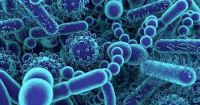Cytotoxicity with Brine Shrimp Lethality Test, Antibacterial Activity, and Dipeptidyl Peptidase IV (DPP IV) Inhibitory Activity of Red Betel (Piper cf. arcuatum Blume) Stem Extract
Main Article Content
Abstract
Piper cf. arcuatum Blume is a plant that has long been used in traditional medicine in Indonesia. The community has used the leaves as antioxidants, antimicrobials, antidiabetics, anti-inflammatory, and anti-cancer agents. However, the stem part of Piper cf. arcuatum Blume has not been widely used. In this study, we evaluated the cytotoxicity, antibacterial, and antidiabetic properties of hexane, ethyl acetate, and methanol extracts of Piper cf. arcuatum Blume stem. Cytotoxicity was assessed using the Brine Shrimp Lethality Test (BSLT) with Artemia salina larvae. Evaluation of its antibacterial properties against Escherichia coli and Bacillus subtilis and antidiabetic evaluation via dipeptidyl peptidase IV (DPP IV) inhibition. Based on the results of this research, the three extracts showed very strong cytotoxic effects, with LC50 values of 14.65, 17.38, and 33.74 ppm, respectively. In contrast, E. coli and B. subtilis bacteria did not appear to be significantly affected. The methanol extract possesses the highest potential for inhibiting DPP IV, with a % inhibition value of 49.23±0.1%. These findings indicated that the stem of Piper cf. arcuatum Blume could potentially function as an antidiabetic agent and can prevent cancer.
Downloads
Article Details

This work is licensed under a Creative Commons Attribution-NonCommercial-NoDerivatives 4.0 International License.
References
1. Irawan C, Hendara, Nurhayati N, Nurlela, Widyasmara A, Putri ID. Red Betel Leaf (Piper cf. arcuatum Blume) Ultrasound-Assisted Extraction Optimization and Their Potential Anti-Uric Acid and Antioxidant Activity. Rasayan J of Chemistry. 2023; 16(2): 1042-1049.
2. Irawan C, Foliatini, Hanafi. GC-MS Composition of Leaf Extract of Piper cf. arcuatum Blume and Their Antioxidant Activity and Toxicity Studies. J. Pharmacogn. Phytochem. 2017; 6(4): 461-468.
3. Lister INE, Ginting CN, Girsang E, Nataya ED, Azizah AM, Widowati W. Hepatoprotective Properties of Red Betel (Piper crocatum Ruiz and Pav) Leaves Extract Towards H2O2-Induced HepG2 Cells Via Anti-inflammatory, Antinecrotic, Antioxidant Potency. Saudi Pharm. J. 2020; 28(10): 1182-1189.
4. Janakiraman N, Johnson M. Ethanol Extracts of Selected Cyathea Species Decreased Cell Viability and Inhibited Growth in MCF 7 Cell Line Cultures. J Acupunct Meridian Stud. 2016; 9(3): 151-155.
5. Parida S, Sharma D. The Microbiome and Cancer: Creating Friendly Neighborhoods and Removing the Foes within. Cancer Res. 2021; 81: 790-800.
6. Uddin TM, Chakraborty AJ, Khusro A, Zidan BMRM, Mitra S, Emran TB, Dhama K, Ripon MKH, Gajdács M, Sahibzada MUK, Hossain MJ, Koirala N. Review-Antibiotic Resistance in Microbes: History, Mechanisms, Therapeutic Strategies and Future Prospects. J Infect Public Health. 2021; 14: 1750-1766.
7. Alberti KG, Zimmet PZ. Definition, Diagnosis and Classification of Diabetes Mellitus and Its Complications. Diabet Med. 1998; 15(7): 539-553.
8. Irawan C, Elya B, Hanafi M, Saputri GC, Potential Ethanol Extract of Rhinachantus nasutus (L) Kurz Stem Bark as Antioxidant and Inhibitor of Dipeptydyl Peptidase IV (DPP IV) Activity. Research J Pharm Tech. 2023; 16(3): 1187-1192.
9. Irawan C, Elya B, Hanafi M, Saputri FC. Evaluation of Cytotoxic, Anti-Inflammatory and Antibacterial Activities of Ethanol Extract of Rhinachantus nasutus Leaves. Intl J Agric & Biol. 2023; 29(6): 421-425.
10. Banjara R, SK Jadhav, SA Bhoite (2012). Antibacterial Activity of Di-2-Ethylaniline Phosphate Screened by Paper Disc Diffusion Method. J Appl Pharm Sci. 2012; 2: 230-233.
11. Cayman Chemical Company. DPP (IV) Inhibitor Screening Assay Kit. Cayman Chemical Company: Ann Arbor, MI, USA. 2017.
12. Meyer BN, Ferrigni NR, Putnam JE, Jacobsen LB, Nichols DE, McLaughin JL. Brine Shrimp: A Convenient General Bioassay for Active Plant Constituent. Plant Med. 1982; 45: 31-34.
13. Elsyana V, Bintang M, Priosoeryanto BP. Cytotoxicity and Antiproliferative Activity Assay of Clove Mistletoe (Dendrophthoe pentandra (L.) Miq.) Leaves Extracts. Adv Pharmacol Sci. 2016; 2016(3242698):1-6.
14. Niksic H, Becic F, Koric E, Gusic I, Omeragic E, Muratovic S, Miladinovic B, Duric K. Cytotoxicity Screening of Thymus vulgaris L. Essential Oil in Brine Shrimp Nauplii and Cancer Cell Lines. Sci Rep. 2021; 11(1): 13178-13186.
15. Benkova M, Soukup O, Marek J, Review-Antimicrobial Susceptibility Testing: Currently Used Methods and Devices and the Near Future in Clinical Practice. J Appl Microb. 2020; 129: 806-822.
16. Madigan MT, Martinko JM, Parker J. Brock Biology of Microorganisms, 9th Edition. Prentice-Hall Inc. New Jersey. 2000.
17. Pissurlenkar RRS, Shaikh MS, Coutinho EC. 3DQSAR Studies of Dipeptidyl Peptidase IV Inhibitors Using a Docking-Based Alignment. J Mol Model. 2007; 13(10): 1047-1071.
18. Kimata H, Fukuda-Tsuru S, Yoshida K, Iwasaki S, Kiuchi S, Akahoshi F, et al. Teneligliptin, A Novel Selective Dipeptidyl Peptidase-4 Inhibitor, Improves Postprandial Hyperglycemia in a Model of Type 2 Diabetes, Zucker Diabetic Fatty Rats. Med Consult New Remedies. 2012; 49(8): 1060-1066.
19. Lalitha N, Sadashivaiah B, Ramaprasad TR, Singh SA. Anti-Hyperglycemic Activity of Myricetin, Through Inhibition of DPP-4 and Enhanced GLP-1 Levels, is Attenuated by Co-Ingestion with Lectin-Rich Protein. PLoS One. 2020; 15(4): 1-19.
20. Robbani S, Elya B, Iswandana R. Alpha-Glucosidase and DPP-IV Inhibitory Activities of Ethanol Extract from Caesalpinia sappan, Andrographis paniculata, and Syzygium cumini. Pharmacogn J. 2022; 14(3): 702-709.
21. Shehadeh MB, Suaifan GARY, Odeh AMA. Review: Plants Secondary Metabolites as Blood Glucose Lowering Molecules. Molecules. 2021; 26(4333): 1-46.
22. Haq IU, Imran M, Nadeem M, Tufail T, Gondal TA, Mubarak MS. Piperine: A Review of Its Biological Effects. Phytother. Res. 2020; 35: 680-700.


